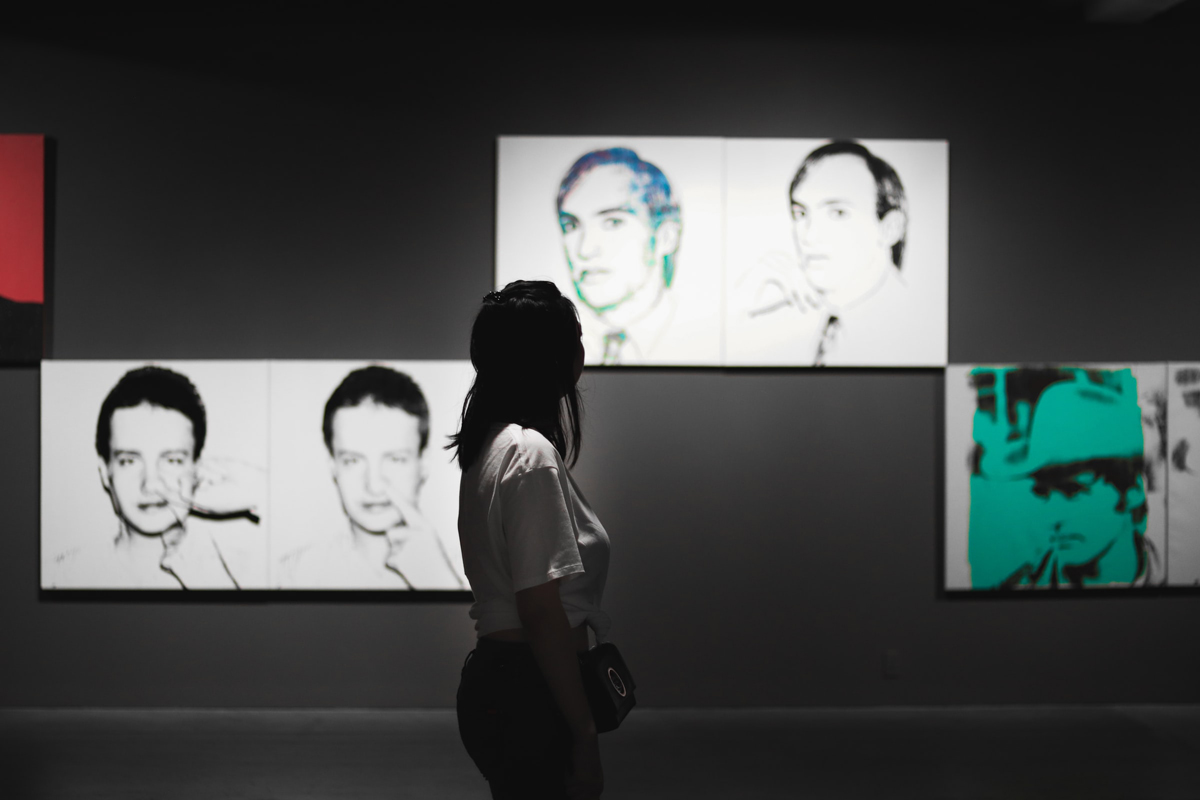Dr Jaime Hsu Fang-Tze, Lecturer | 6-min read
25 October 2022 — On 21 February 2021, an artwork by Beeple (pseudonym of artist Mike Winkelmann) entitled Everydays: The First 5000 Days that was minted into a Non-Fungible Token (NFT) was sold for US$69,346,250 during a Christie’s online auction. Since then, the value of art has captured the attention of the general public, thanks to the extensive coverage from major news outlets pervasive sharing of news of the sale by users of social media.

A short tour of the Andy Warhol Museum in Pittsburgh. An audience is wandering through some portraits by Andy Warhol. Image courtesy of Mingjun Liu. Retrieved by the author from unsplash.com/photos/sIQjmV4Avsg.

Image created by Tezos. Retrieved by the author from unsplash.com/photos/5NX5x2-O7KU.
Everydays: The First 5000 Days, a collage of 5,000 images that occupied 13 years of Winkelmann’s life with making, embodies the artist’s dedication and extended artistic labour, although these are not what kindled the feverish reaction of the people. It is about the financial transactions happening around Everydays: The First 5000 Days, which involves how its provenance is stored in a NFT. This metadata which includes where the files are stored is recorded by the NFT, which is a tradeable token. The protocols of NFTs are traced to Cryptokitties, a collectables crypto game built on the Ethereum chain. The sale of Everydays for $69 million propelled the buyer, the artist and this technology to mainstream fame.
An artwork’s provenance “refers to the history of the ownership of a painting or other work of art”.1 It is a critical document in the authentication process that ultimately determines the economic value of an artwork. As Iain Robertson, the head of Art Business Studies at Sotheby's Institute of Art, indicates, “The authenticity of a work impacts upon its desirability for potential investors, which increases the potential for it to be considered as a store of value”.2 However, can the value of an artwork’s certified ownership equate to the value of an artwork?
To better unpack this perplexity, let us start with some fundamental questions. How do we value art? What value has arts created? Arts have been an integral part of our society. It is the artistic creativity that differentiates human beings from other species. While arts are at the centre of cultural conceptualisation, the perplexity of value and the valuation of arts have blossomed into academic fields and professional occupations. Because the scope of arts is remarkably vast, and almost any form of creative action can fit under its roof, how does it continue to operate in accordance with public evaluations? It is that mutual recognition of art's value that communicates artistic practitioners with their audiences and forms the essence of communities and culture.
David Graeber, an anthropologist specialised in value theory, has argued, “[v]alue emerges in action; it is the process by which a person’s invisible “potency”—their capacity to act— is transformed into concrete, perceptible forms.”3 Graeber identifies, commonly speaking, that there are three ways to talk about value—values in a sociological sense, value in the economic sense, and value in the linguistic sense.4 To explore the “sociological values” of Everydays: The First 5000 Days based on Graeber’s framework, one would need to ask, what ultimately good, proper, or desirable in human life is Everydays: The First 5000 Days?
The answer to this question could be arbitrary because there is no homogenous kind of “human life”, not to mention the impossibility of finding a consensus on what is good, proper, or desirable. However, it is specifically through the process of a collective attempt to find the common ground on answering these questions, a group of humans would find the essential cultural identity that defines them as a community. In a linguistic sense, Graeber frames the conception of value as a “meaningful difference” that differentiates the creation from its original source. In other words, linguistically speaking, the value of a painting could refer to a “meaningful difference” created from its original source, which is paints and canvas. Therefore, in the linguistic sense, the value of Everydays: The First 5000 Days could lay in the “meaningful difference” between its final form as a digital collage and the 5,000 images created by Winkelmann throughout the 13 years of his life; most importantly, in his artistic creativity.
In the case of discussing Everydays: The First 5000 Days’ economic value, Graeber’s observation would require some extra contextualising information. According to Graeber, “‘value’ in the economic sense [refers] to the degree to which objects are desired, particularly, as measured by how much others are willing to give up to get them”.5 Since what has been sold during the Christie’s online auction on 21 February 2021 is an NFT representing a digital collage titled Everydays: The First 5000 Days, what can be determined here is actually the monetary value of this work of art’s provenance that has been evaluated through a market mechanism called auction, and the valuation of its provenance is $69 million. Simply put, the financial transaction between the seller and the buyer is not based upon the work of art. Still, it is mediated through blockchain-certified ownership of the artwork represented in a bar code called NFT, which is secured within a blockchain-like Etherium.
However, incorporating new technology such as blockchain to accelerate the economic dynamics of the art ecosystem is not a bad idea. In fact, by enabling artists to mint their digital artworks into a NFT, the blockchain-based protocol solves one of the main headaches for artists who create digital arts and their collectors–a certified scarcity. Even Guillaume Cerutti, Christie’s Chief Executive Officer, has praised, “the possibility to secure the uniqueness and authenticity of this work on the blockchain”.6 Because NFT could ensure the non-fungibility and uniqueness of digital assets, the technology enhances the monetary value of digital artwork and any creative forms of intellectual property.
If NFTs could potentially elevate the marketability of digital art, why might it be a bad idea to use the term, NFT Art? Apart from digital art conservators’ concern about the obsolescence of media file storage in blockchain7 and the issues concerning owner’s right to the actual digital asset8, the economic value of an online ledger that keeps the records of ownership of the artwork should not be conflated with the value of the artwork when it is circulated in a value chain with public outlook. A significant proportion of the Mona Lisa’s economic value comes from its contribution to the ticket sales of the Louvre Museum, art tourism in France, and all the sales revenue of commodities containing the image that circulate the globe. Although the possibility of seeing Mona Lisa breaking records in an auction fairly low, it does not compromise the artwork’s contribution to the growth of the creative economy in a world scale.
The reason for not calling NFTs an art may lie not only in the limitation of the Ethereum smart contract protocol for conveying the aesthetic entirety of digital assets. It is also due to the public value of art beyond its monetary valuation. Arts can be a good business as long as we are clear what art is and what it has to do with its value transaction.
1 London The National Gallery, “Glossary,” Provenance | Glossary | National Gallery, London, accessed July 2, 2022, https://www.nationalgallery.org.uk/paintings/glossary/provenance#:~:text=Provenance%20refers%20to%20the%20history,themselves%20and%20auction%20sale%20catalogues.
2 Jos Hackforth-Jones and Iain Robertson, Art Business Today: 20 Key Topics. London: Lund Humphries, P. 1742, 2016. Kindle Version.
3 David Graeber, “Three Ways of Talking about Value,” in Toward an Anthropological Theory of Value (New York: Palgrave Macmillan, 2001), P. 45.
6 Angelica Villa, “5 Andy Warhol Nfts Are Heading to Auction. Art Experts Question Their Authenticity.,” 5 Andy Warhol NFTs Are Heading to Auction. Art Experts Question Their Authenticity (ARTNews, May 24, 2021), https://sg.style.yahoo.com/5-andy-warhol-nfts-heading-190000187.html.
7 Jon Ippolito, “Crypto-Preservation and the Ghost of Andy Warhol,” Arts 11, no. 47 (2022), https://doi.org/10.20944/preprints202202.0346.v1.
8 According to CONDITIONS OF SALE FOR CHRISTIE’S INC.,
Your purchase of the lot does not provide any rights, express or implied, in (including, without limitation, any copyrights or other intellectual property rights in and to) the digital asset underlying the NFT other than the right to use, copy, and display the digital asset for your own personal, non-commercial use or in connection with a proposed sale or transfer of the NFT and any other right expressly contained in these Conditions of Sale.
Conditions of Sale: Buying at Auction,” Christie’s , accessed July 7, 2022, https://www.christies.com/buying-services/buying-guide/conditions-of-sale.
To learn more about the MA ACE programme, click here.